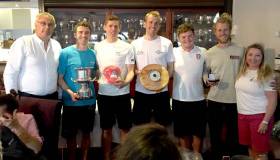Displaying items by tag: Cillian Dickson
Cillian Dickson of Lough Ree & J/24 Headcase Crew Are “Sailors of the Month (Int. Regatta)” for August
The story of the restored J/24 Headcase in recent years has been a particularly heart-warming one of all-Ireland camaraderie and success, and in August the emphasis was firmly on international success with a final race victory to give a two-point win in the J/24 Europeans on Lake Balaton in Hungary, racing against 42 boats from eight nations.
Yet even with a team effort of this quality, we have to narrow the “Sailor of the Month” to one identifiable individual, and helmsman Cillian Dickson of Lough Ree YC and Howth YC has emerged as “The Face of Headcase”, spokesman for a close-knit yet multi-background squad which includes Marcus Ryan and Louis Mulloy of Mayo SC, Ryan Glynn of Ballyholme YC, and Sam O’Byrne of Howth YC
Cillian Dickson is 'Sailor of the Month (Keelboats)' for August 2019
When the J/24 Headcase snatched the overall win in the final races of the J/24 Nationals 2019 on Lough Erne, inevitably it was a team effort with the boat carrying the usual complement of five. But as we have to narrow it down, the title goes to helmsman Cillian Dickson of Lough Ree and Howth. Yet it has to be said that he drives for a formidable and truly all-Ireland squad. Four of Headcase’s crew own her together – they are Cillian Dickson (LRYC & HYC), Sam O’Byrne, (HYC), and Louis Mulloy and Marcus Ryan, both of Mayo SC. As for the fifth hand, he is invariably Ryan Glynn of Ballyholme YC on Belfast Lough. A diverse crew perhaps, but they functioned together like clockwork to hit the bullseye twice, as the National title secured them a place in the conveniently-located Worlds in Poole in the south of England next year.





























































